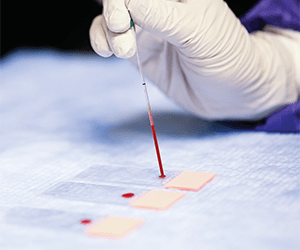Discover Together Biobank: A Model for Collaborative Pediatric Biobanking
In terms of biospecimen storage, there’s nothing radical about the Discover Together Biobank at Cincinnati Children’s. Like many biobanks, the facility stores carefully packaged and cataloged tubes of blood, vials of saliva and other tissue samples for research use.
What makes this biobank a model for others to emulate is how its builders put it together. The project reflects years of engagement between scientists, multiple research institutions, and the research participants themselves—right down to the name itself. Together, they have produced one of the largest pediatric biospecimen collections in the United States, a uniquely valuable resource for those working to cure the rarest childhood diseases and conditions.
Biobanks are critically important to research and ensure that investigators have access to patient samples and data at a scale that accelerates the starting point for research studies. The Discover Together Biobank exists to improve individual and community health through high-impact biobanking research, participant engagement, and collaboration.
The aim is to build a vast resource with broadly consented and engaged participants that provides Cincinnati Children’s researchers and collaborators with high-quality biospecimens and data to accelerate discoveries. The goal is that participants will remain engaged with the biobank and learn about the life-changing discoveries that they helped enable. “Discover Together” emphasizes that investigators and participants are equally critical to successful research and discovery.
Large and Growing Collection
Over the years, Cincinnati Children’s has invested more than $10 million for biobanking facilities and technology. So far, the Discover Together Biobank’s collected data and specimens include:
- A deidentified data warehouse of 1.2 million electronic patient records (EHRs)
- More than 95,000 DNA samples
- More than 1,300 serum and plasma samples
- More than 4,000 urine samples
- More than 37,000 residual tissue samples
A New Biobank Decades in the Making
The Discover Together Biobank was revamped and renamed in 2018. But investigators at Cincinnati Children’s have been collecting tissues and other samples for many years, including institutional samples collected under the Better Outcomes for Children protocol, the Genomic Control Cohort, and other legacy collections.
The reorganized biobank consolidates these samples along with a rapidly growing collection of newly donated material—all collected under a broad, unified set of informed consent and data access protocols.
“The new structure of the biobank makes it much more practical for investigators to not only tap into an established collection of samples for current research, but also to query the participants for future studies when needed,” says Mike Pauciulo, MBA, Director, Discover Together Biobank. “Additionally, the biobank is now positioned to enable deeper collaboration among multiple institutions.”
GRIN Project Drives Multicenter Collaboration
The biobank’s structure aligns with an effort launched in September 2014, when leaders from Cincinnati Children’s, Boston Children’s and Children’s Hospital of Philadelphia (CHOP) agreed to form the Genomics Research and Innovation Network (GRIN).
The idea was to pool the brainpower of some of the world’s best pediatric clinicians and researchers to use exploding volumes of genomic data to dig deeper into the causes and potential cures of more than 7,000 mostly rare pediatric diseases. Through collaboration, GRIN could help investigators magnify the significance of their work.
From IRB agreements to material transfer protocols, the GRIN team devoted a year to building the regulatory and legal infrastructure to allow the three hospitals to share information. Since then, the Discover Together Biobank has played a core role in supporting a growing library of genomic, proteomic and metabolomic data.
In October 2019, the GRIN collaborators were awarded an $8.5 million grant from the National Center for Advancing Translational Sciences to support expanding the network into a larger “federation” of medical centers that are legally, ethically, and technically equipped to share large volumes of data.
UPMC in Pittsburgh and Washington University in St. Louis have joined the project, and investigators at several of the participating institutions have already begun publishing new discoveries based on shared GRIN data.
A Major Resource for Large-Scale Research
The Discover Together Biobank continues to work with investigators to align consent protocols so that even more patient cohorts can become accessible to collaborators. As it grows, the biobank has become an important resource for national and international projects.
One example is the national Electronic Medical Records and Genomics (eMERGE) program, funded by the National Human Genome Research Institute. In 2017, Cincinnati Children’s received a four-year, $3.4 million NIH grant in the third phase of the eMERGE project to evaluate the role of 100 genes in the genomes of 2,500 patients. That project has been led by John Harley, MD, PhD.
Another example is a study of selenium deficiency and preterm birth in African and Asian populations, which has been led by Drs. Louis Muglia, Ge Zhang, and Nagendra Monangi. This study has involved the Discover Together Biobank processing thousands of blood samples collected in various African and South Asian countries so that genotyping data can be generated and maternal plasma selenium measured. The Bill and Melinda Gates Foundation provided funding that will continue this important research study into the future.
But these are just the opening chapters of a much larger story.
“No matter how big each one of our hospitals gets, we still cannot build cohorts large enough to make transformational progress against a number of rare diseases,” says Tracy Glauser, MD, Associate Director of the Cincinnati Children’s Research Foundation. “Although these institutions may compete clinically, we felt the time was right in genomics to collaborate. We are excited to see how these opportunities for discovery unfold.”




